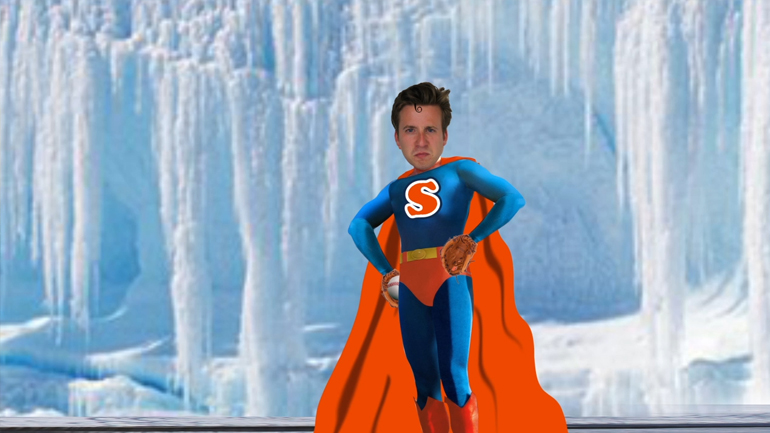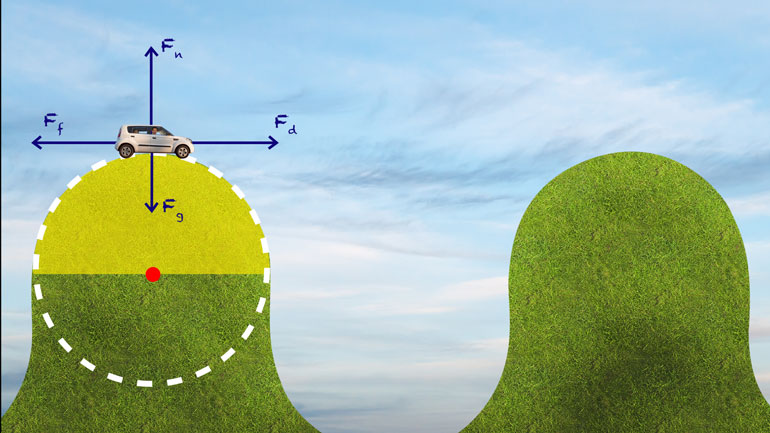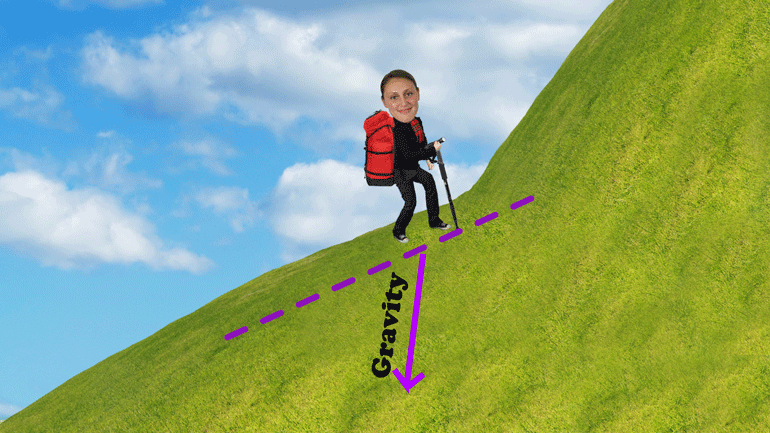ShmoopTube
Where Monty Python meets your 10th grade teacher.
Search Thousands of Shmoop Videos
Physics Videos 34 videos
Isaac Newton. Who was he? Why do we need to know about him? In a physics course, no less? Well, he's only the most famous physicist in history, and...
What are the basics of trigonometry? And why are we learning about this in a physics course? Both good questions. In this video, you'll learn about...
It's time to make our liters and meters work together. Enough of the bickering, right? In this video, we'll do some unit analysis, covering SI Unit...
Physics: More Fun with Vector Components 14 Views
Share It!
Description:
Time to have more fun with vector components! What's that? You've never had any fun with vector components? Huh...then...time to spend more time with vector components!
Transcript
- 00:02
Putting it all together: more fun with vector components we say fun with
- 00:08
vector component that's like fun....
- 00:20
all right story time yeah I'll do that
- 00:26
okay time to take a break from vectors and hit the slopes just glide down a [Man skiing on the slopes]
- 00:31
mountain letting gravity do all the work moving horizontally and vertically in a
Full Transcript
- 00:35
diagonal direction, uh-oh sounds like a two-dimensional vector doesn't it make
- 00:40
sense skiing is a lot like that experiment Galileo did the one where he [Galileo skiing down a mountain]
- 00:45
discovered the force of gravity by rolling a ball down a ramp a bunch of
- 00:48
times except with skiing we don't have some old Italian guy timing us with a
- 00:52
water clock and like we said gravity will be the force that's sending us
- 00:56
downhill sadly our jet-powered skis haven't been [Man with jet-powered skis appears]
- 00:59
delivering us yet so there won't be any horizontal acceleration just vertical
- 01:03
however because we'll be going down on an incline aren't we're all velocity
- 01:08
magnitude will be increasing but hold on we're really awesome at skiing so we'd [Man performs ski jump]
- 01:14
be doing all sorts of radical jumps and stuff right and it would throw off all
- 01:18
the math so instead we'll be observing the motion of our buddy Rex
- 01:23
Tyrannosaurus Rex yeah he's a newbie to this winter wonderland so he'll just [T-Rex skiing down mountain]
- 01:27
hope to stay upright.... so let's say t-rex is going down a mountainside and
- 01:36
for the sake of simplicity we'll say this is a completely frictionless
- 01:40
ice-covered hill and we'll put the hill in an angle of 40 degrees you know what
- 01:45
Rex's speed went from 200 meters from the ski lift, first things first we
- 01:50
know the total distance along this diagonal yeah Rex just keep skiing
- 01:56
and we know the angle of incline well do we have enough to calculate the velocity
- 02:03
well the best equation to use would be this one it tells us that the square of [Equation of velocity appears]
- 02:07
the final velocity equals the square of the initial velocity plus two times the
- 02:12
acceleration times the distance well the initial velocity will be zero and the
- 02:17
distance will be 200 meters but we don't have the acceleration let's take care of
- 02:22
that problem right now as the Italian stallion
- 02:26
Galileo himself taught us acceleration down an incline equals the force of [Galileo appears galloping on a horse]
- 02:31
gravity times the sine of the angle of inclination well the acceleration of
- 02:37
gravity is 9.8 meters per second squared just like always when we multiply that
- 02:42
times the sine of 40 degrees we get an acceleration of six point three meters
- 02:45
per second squared which is a lot of acceleration for a nine-ton reptile okay
- 02:51
now we can use that velocity equation we looked at before since the initial
- 02:55
velocity is zero the square of the final velocity equals two times the
- 02:59
acceleration times the distance well doing that math gives us two thousand
- 03:03
five hundred twenty meters per second ah but we need to find the square root of
- 03:06
that number to be able to find the final velocity while taking the square root
- 03:11
gives us a final velocity of fifty point two meters per second but there might be
- 03:15
a little problem remember when we said Rex was new to this whole skiing thing [People skiing and T-Rex appears]
- 03:20
and that he's super big yeah he's not gonna be stopping anytime soon in fact
- 03:25
it looks like he's gonna go over the edge of the mountain which would be [T-Rex falls off edge of mountain]
- 03:28
about 12 meter fall before he hits the ground below so what's the speed at the
- 03:33
bottom of this tumble well in this case the initial velocity is definitely not
- 03:37
zero after all we just figured out that our big friend was going fifty point two
- 03:41
meters per second and since this is a vector quantity it needs a direction as
- 03:46
well that direction was 40 degrees but we need to break that velocity down into
- 03:50
its vertical and horizontal components and yep we're getting triggy with it all
- 03:54
right so if we put this on a graph we can see that we have a right triangle
- 03:57
here and the velocity that we calculated is the hypotenuse of that triangle [Triangle appears on graph]
- 04:02
hypotenuse that thing right there since we know the incline angle we can use
- 04:06
trig functions to find out the magnitude of the component velocities which make
- 04:11
up the other sides of this triangle, time for for sohcahtoa
- 04:15
...... it's not an island in the South
- 04:21
Pacific it's how we remember our primary trig functions well the soh when
- 04:26
sohcahtoa reminds us that the sine of an angle equals its opposite side divided
- 04:31
by the hypotenuse so the sine of 40 degrees equals v sub y over 50 point two
- 04:36
meters per second when we multiply each side by fifty point two meters per
- 04:40
second we find that the vertical velocity v sub y equals 32.3
- 04:45
meters per second all right now for the horizontal velocity that makes up the [Triangle appears with horizontal velocity]
- 04:50
adjacent side of our triangle which means we need to use the cah in
- 04:54
sohcahtoa the cosine of an angle equals its adjacent side over the hypotenuse so
- 05:00
once again we multiply both sides of the equation by the hypotenuse to solve for
- 05:04
v sub x well that math we're doing here tells us that the horizontal velocity is
- 05:10
38.5 meters per second okay we're making progress on this velocity stuff and
- 05:15
Rex is making progress getting himself upright yeah [Rex attempts to stand up from ditch]
- 05:20
those little arms aren't helping though all right now we can find the vertical
- 05:23
velocity that Rex achieved right before he hit the ground to do that we'll use
- 05:27
this equation again well this time we do have an initial velocity it's a thirty
- 05:32
two point three meters per second we just figured out a minute ago and the
- 05:36
acceleration will just be our good old 9.8 meters per second squared buddy
- 05:41
there aka gravity, oh in the displacement well that'd be the twelfth meter plummet
- 05:47
we plug in those numbers don't forget to find that square root and we get a final
- 05:52
velocity of thirty five point eight meters per second and that's it all done
- 05:56
we just need some hot cocoa and a paleontologist make sure Rex didn't break [Man with skis appears at lodge]
- 06:00
any bones but oh wait there's one more things there always is we have our final
- 06:06
vertical velocity and the horizontal velocity stayed the same
- 06:09
until the Dino met the ground yeah but we need to figure out the combined
- 06:15
velocity to get our actual final vector and we can do that with the Pythagorean
- 06:20
theorem Pythagorean theorem that was
- 06:23
Pythagoras' best theorem by far for this triangle v sub x squared plus v sub
- 06:28
y squared will equal the square of the combined velocity so when we add the [Equations appear]
- 06:34
squares and find that square root we get a final velocity 52.6 meters per second
- 06:39
so Rex didn't pick up a ton of speed on his way down but it was only a 12 meter
- 06:43
fall so not a big deal when we have a problem where the motion changes we need
- 06:48
to be sure to break those motions into separate chunks then we just need to
- 06:53
make sure we're using the right equation and that we're keeping track of any [Rex skiing down a slope]
- 06:56
changes in the vector components like when Rex went off that cliff
- 07:00
we had to factor in the vertical velocity he started with when he began
- 07:04
as freefall to get the right combined velocity so make sure to take things
- 07:08
step by step and pay attention to anything that needs to be carried over
- 07:11
from the previous step all right let's go back to the lodge hope they have [man with skis appears at the lodge]
- 07:15
those little marshmallows for the cocoa but Rex is still having a hard time
- 07:19
trying to deal with all his you know equipment well looks like he's got his
- 07:23
helmet balanced on top of one of his skis and he's trying to take those
- 07:26
boots off at the same time if that ski tips so that one end is 60 centimeters
- 07:31
lower than the other and the ski is 2 meters long well what are the final
- 07:35
velocity x and y-components for the helmet when it slides down and off the
- 07:39
ski ok oh this looks pretty familiar we just need to find the acceleration, well
- 07:44
acceleration equals gravity times the sine of the theta angle but we don't
- 07:48
know the degrees of that angle so more thinking, like we said before the sine of
- 07:53
an angle equals its opposite over the hypotenuse when we have the length of
- 07:58
the opposite side which is 60 centimeters and we have the hypotenuse
- 08:01
which is 2 meters well to find the angle it's almost like we need to work
- 08:05
backwards actually it's exactly like we need to work backwards like every trig [Rex skiing backwards]
- 08:09
function has an inverse function so if the sine of x equals y the inverse sine
- 08:16
of y equals x the inverse functions can look like this with a cute little
- 08:20
negative 1 in superscript like that or you can add arc to the beginning of the
- 08:25
function so the inverse of tangent is arctangent in the inverse of cosine is [inverse tangents appear]
- 08:30
arc cosine and the inverse of sine is arc sine so let's make sure our
- 08:34
calculator is set to use the inverse functions and that it's in degree mode [Rex using calculator]
- 08:39
and let's put in those numbers all right the arc sine of 60 meters which we'll
- 08:43
put in terms of meters over 2 meters equals 17 point five degrees now if you
- 08:49
use that number to find the helmets acceleration as it slides down the ski [helmet slides down the ski]
- 08:52
just isn't Rex's day so we'll go back to our acceleration equation acceleration
- 08:58
equals gravity 9.8 meters per second squared times the sine of the theta
- 09:02
angle which is 17.5 degrees okay so the helmet is picking up speed at a rate of
- 09:07
2.94 meters per second too fast for a dinosaurs slow
- 09:11
reflexes especially in the cold but remember we're trying to figure out the [Helmet hits man on the head]
- 09:15
final component velocities here but to do that we need to find the combined
- 09:20
velocity first we'll use this equation again and the initial velocity will be
- 09:25
zero so we just need to calculate 2 times the acceleration times the 2 meter
- 09:30
distance, O and find the square root so our combined final velocity is 3.4 [Combined final velocity equation appears]
- 09:36
meters per second and that's it okay now we're in the homestretch we
- 09:41
just need to break that vector down to its components it's important to
- 09:44
recognize that earlier when we were figuring out the degrees of the incline we
- 09:48
were working with lengths we weren't using velocity vectors just plain old
- 09:52
scalar lengths so even though the triangle looks the same we're working on
- 09:56
a whole new level well to find the component velocities we
- 10:00
just need a little bit more trig and then we're done to find the horizontal
- 10:03
vector we'll multiply our combined velocity times the cosine of the
- 10:07
17.5 degree angle making the velocity in the x-direction
- 10:13
3.27 meters per second and the vertical well, same basic idea except
- 10:19
we'll be using the sine instead of the cosine which gives us a vertical
- 10:23
velocity of 1.03 meters per second and yeah that makes sense since the [Skis propped up against a tree]
- 10:28
angle isn't very steep most of the velocity is along the horizontal axis
- 10:33
that's why the horizontal side of our triangle is a lot longer than the
- 10:37
vertical these lines represent the magnitude of these vectors see all that [Boy and Rex sat at a table]
- 10:41
works out okay now we're done for reals this time turns out all this ski stuff
- 10:46
was just an excuse to do more math, in reality were terrible at skiing we do
- 10:51
have a t-rex friend though....[Rex eats boy]
Related Videos
When you're about to marry the love of your life, not many things could stop you. However, finding out that your future hubby is keeping his crazy...
Here at Shmoop, we work for kids, not just the bottom line. Founded by David Siminoff and his wife Ellen Siminoff, Shmoop was originally conceived...
ACT Math: Elementary Algebra Drill 4, Problem 5. What is the solution to the problem shown?
AP® English Literature and Composition Passage Drill 1, Problem 1. Which literary device is used in lines 31 to 37?
AP® English Literature and Composition Passage Drill 2, Problem 1. What claim does Bacon make that contradicts the maxim "Whatsoever is delig...






































